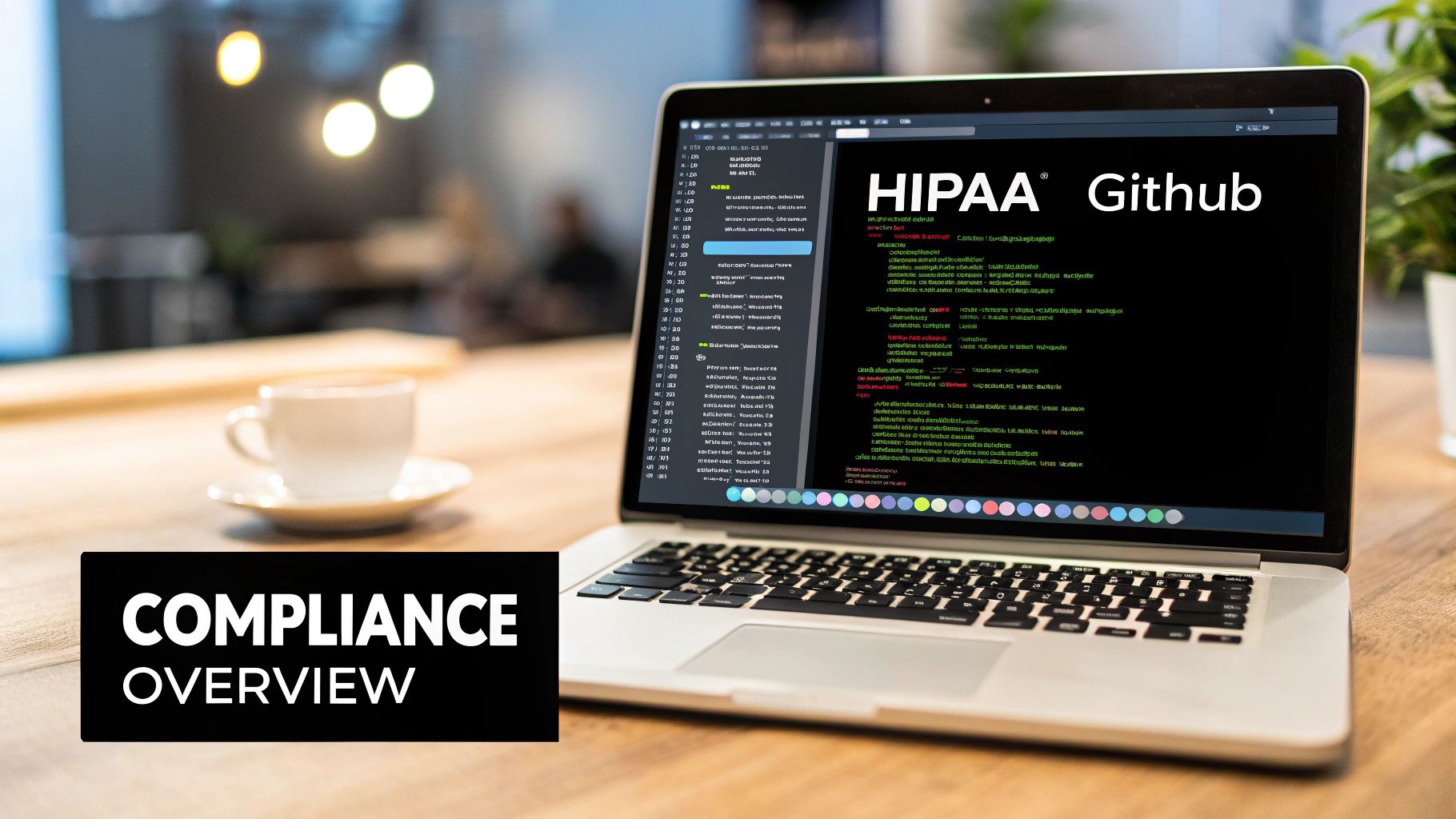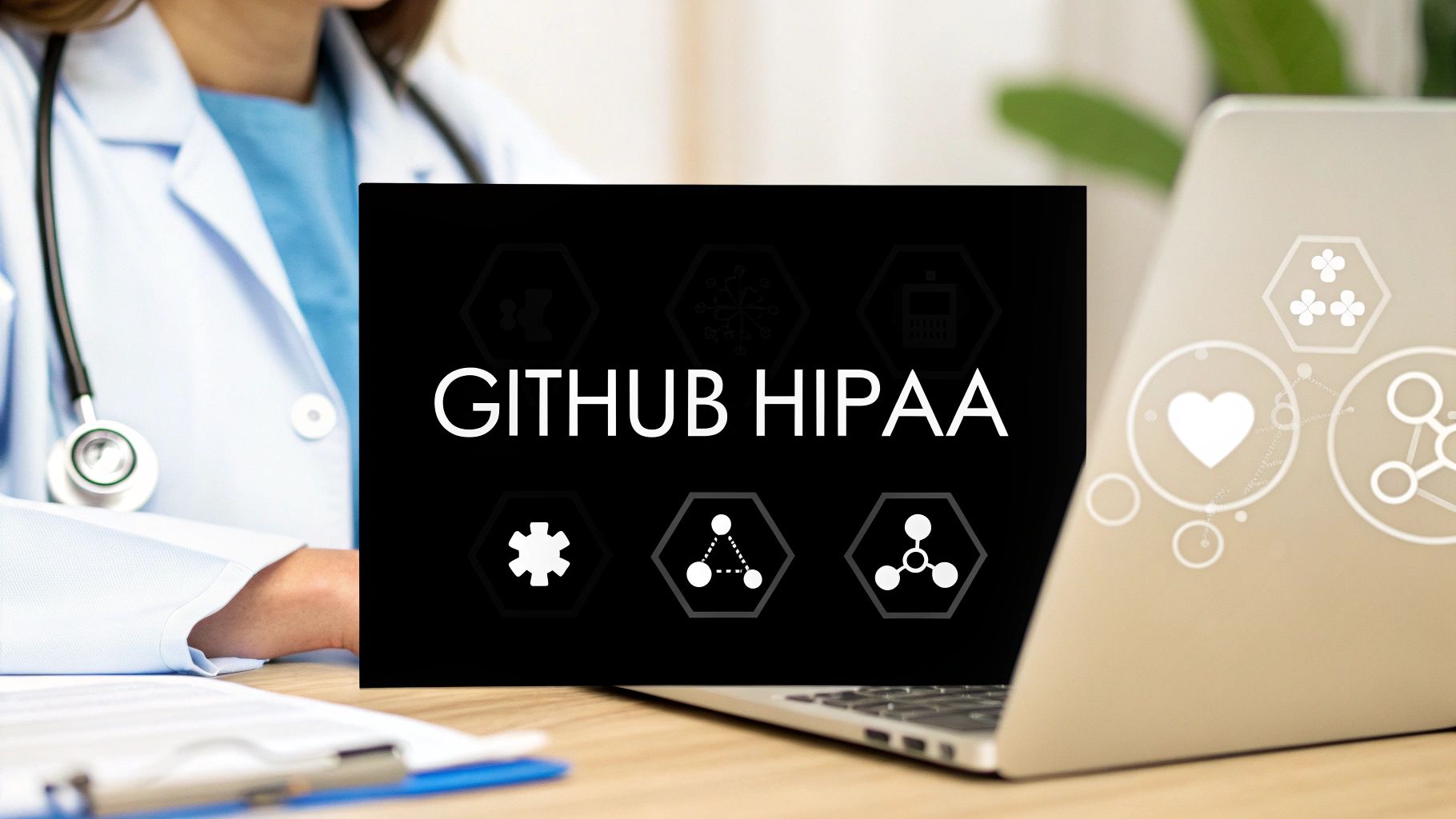github hipaa compliance: Strategies for Healthcare
Navigating GitHub in Modern Healthcare Development

GitHub has become a vital tool for collaborative software development, offering robust version control and project management features. This is especially relevant in the rapidly evolving healthcare sector. However, the sensitive nature of patient data requires careful consideration when using this platform, particularly regarding HIPAA compliance. Balancing collaboration with the strict requirements of protecting Protected Health Information (PHI) presents a considerable challenge.
Understanding the Risks
While GitHub offers significant potential for improving healthcare software development, it also introduces risks if not used carefully. Public repositories, if not configured correctly, can inadvertently expose sensitive information. This could include source code with embedded credentials, internal documentation containing patient identifiers, or even entire databases with PHI.
Such exposures can lead to significant HIPAA violations and compromise patient privacy. This highlights the need for strong security measures and a deep understanding of GitHub’s features and settings. Healthcare organizations must prioritize educating developers on secure coding practices and proper repository configuration.
Robust access control and consistent audits are vital for risk mitigation. However, the collaborative nature and convenience of GitHub shouldn't be disregarded. It can be a valuable resource for healthcare development teams when appropriate safeguards are in place.
For example, private repositories, combined with strong access control and regular security audits, can provide a secure environment for collaborative development. Unfortunately, data breaches do occur. GitHub has seen instances where sensitive healthcare data, including PHI, was exposed due to improper developer practices.
A 2020 report revealed that at least nine U.S. entities leaked sensitive data via GitHub, impacting between 150,000 and 200,000 patient records. This included hard-coded credentials and abandoned repositories, providing unauthorized access to billing systems and patient information. The most significant incident involved a developer who exposed credentials and PHI for approximately 200,000 clients across multiple healthcare providers. Find more detailed statistics here.
Implementing Best Practices for GitHub HIPAA Compliance
To effectively use GitHub while maintaining HIPAA compliance, healthcare organizations need a comprehensive strategy. This includes the following key practices:
-
Strict Access Control: Implementing role-based access control (RBAC) limits access to specific repositories and data to authorized personnel only. This minimizes the risk of both accidental and deliberate data breaches.
-
Private Repositories: Using private repositories is essential for protecting sensitive code and information. Unlike public repositories, these restrict access to authorized users within the organization.
-
Regular Security Audits: Routine security audits help identify and address potential vulnerabilities before exploitation. These audits should encompass repository configurations, access controls, and user activity.
-
Secure Coding Practices: Training developers in secure coding practices is paramount for preventing vulnerabilities. This education should cover areas like input validation, data encryption, and avoiding hardcoded credentials.
By adopting these practices and fostering a security-conscious culture, healthcare organizations can confidently utilize GitHub’s features while safeguarding sensitive patient data. This proactive approach not only minimizes the risk of HIPAA violations but also builds trust and confidence among patients and stakeholders.
Translating HIPAA Requirements for Code Repositories

The Health Insurance Portability and Accountability Act (HIPAA) presents unique challenges for healthcare software developers using GitHub. The regulations weren't originally designed with code repositories in mind. This can lead to confusion about how to apply them in modern development workflows. Translating these requirements into practical guidelines is critical for maintaining compliance while using GitHub's collaborative features, especially when dealing with Protected Health Information (PHI).
Deciphering the Security Rule
The HIPAA Security Rule outlines safeguards for protecting electronic PHI (ePHI). This includes administrative, physical, and technical safeguards. These safeguards apply to GitHub usage, specifically the technical safeguards.
For example, access control, audit controls, and integrity controls directly relate to how repositories are managed and secured. Understanding these connections is the first step toward achieving GitHub HIPAA compliance.
HIPAA compliance isn't just about technical measures; it also involves policy and procedure. HIPAA mandates that healthcare providers protect patient privacy and demonstrate mechanisms for safeguarding health data. This means establishing clear policies for GitHub usage.
These policies should cover aspects like repository access, branching strategies, and code review procedures. They should complement the technical safeguards to form a comprehensive approach to GitHub HIPAA compliance. Studies show that 71% of patients are aware of HIPAA, and 80% demonstrate knowledge about it through quizzes. Despite this awareness, breaches highlight the challenges in maintaining compliance, particularly with third-party developers. Explore this topic further here.
Practical Steps for GitHub HIPAA Compliance
Translating HIPAA requirements into concrete GitHub practices involves several key actions:
-
Access Control: Restrict repository access to authorized personnel only. Use GitHub's team features and role-based access control to manage permissions effectively. Never use public repositories for code containing or relating to PHI.
-
Audit Trails: Enable GitHub's audit logging features to track user activity within repositories. This provides a record of who accessed what and when, which is essential for demonstrating compliance during audits.
-
Data Encryption: Ensure all PHI within the repository (even in configuration files or test data) is encrypted. Implement robust encryption methods both in transit and at rest to safeguard sensitive information.
-
Secure Coding Practices: Train developers on secure coding principles, particularly regarding handling PHI. This includes avoiding hardcoding sensitive data and using appropriate encryption libraries.
-
Vulnerability Scanning: Integrate automated vulnerability scanning tools into the development pipeline to identify and address security risks in code before deployment.
Addressing Common Misconceptions
One common misconception is that using private repositories equals HIPAA compliance. While private repositories are necessary, they are not sufficient on their own. HIPAA compliance requires a multifaceted approach. This includes access control, audit trails, encryption, and secure coding practices.
Another misconception is that HIPAA doesn't apply to test data. Any PHI, regardless of its purpose, falls under HIPAA regulations and requires the same level of protection.
By addressing these misconceptions and implementing the practical steps outlined above, healthcare organizations can use the power of GitHub while ensuring compliance with HIPAA regulations. This proactive approach builds trust with patients, safeguards sensitive data, and minimizes the risk of costly breaches.
Leveraging GitHub's Built-In Security Features

Beyond private repositories, GitHub provides a robust suite of security features essential for HIPAA compliance. These tools empower healthcare development teams to build secure applications while safeguarding sensitive patient data. When properly configured, these features become a cornerstone of a strong HIPAA compliance strategy within the platform.
Essential Security Features for HIPAA Compliance
Several key GitHub features directly address HIPAA's technical safeguards.
-
Multi-Factor Authentication (MFA): MFA adds an extra layer of security, requiring users to verify their identity through multiple methods. This significantly reduces the risk of unauthorized access, even if credentials are compromised. Enforcing MFA for all users is foundational for strong security.
-
Branch Protection Rules: These rules dictate who can push code directly to specific branches, usually your main or release branches. This helps prevent accidental or malicious changes to critical code and maintains code integrity. This is especially crucial when dealing with code related to Protected Health Information (PHI).
-
Secret Scanning: GitHub's secret scanning helps prevent the accidental exposure of sensitive information like API keys and credentials within the codebase. The feature scans repositories for known patterns, alerting administrators to potential vulnerabilities and preventing unauthorized access.
These are just a few of the security measures available in platforms like GitHub. It's important to remember that the healthcare organization is responsible for ensuring the implementation of these security protocols and tools to guarantee data protection.
Let's talk about responsibility for a moment. GitHub itself maintains various compliance certifications, including GDPR compliance, SOC 1 and SOC 2 Type 2 reports, and FedRAMP LI-SaaS Authorization. Its Information Security Management System (ISMS) is also ISO/IEC 27001:2713 certified. However, the ultimate responsibility for securing data within the platform rests with its users. Learn more about GitHub compliance here: GitHub Compliance.
Choosing the Right GitHub Plan
GitHub offers different plans with varying security features. Choosing the right plan is vital for meeting HIPAA requirements. While the free and Team plans offer basic security, GitHub Enterprise provides advanced controls designed for organizations handling sensitive data.
To illustrate, GitHub Enterprise includes features like SAML single sign-on, enhanced audit logging, and advanced access controls, going beyond the security capabilities of the other plans. This makes GitHub Enterprise the preferred option for healthcare organizations striving for comprehensive HIPAA compliance.
To further understand the differences between the various plans, consider the following table:
GitHub Security Features for HIPAA Compliance: A comparison of GitHub's security features across different plans and how they address specific HIPAA requirements.
| Security Feature | GitHub Free | GitHub Team | GitHub Enterprise | HIPAA Requirement Addressed | |---|---|---|---|---| | Private Repositories | Yes | Yes | Yes | Data Security | | Multi-Factor Authentication (MFA) | Yes | Yes | Yes | Access Control | | Branch Protection Rules | Limited | Yes | Enhanced | Audit Controls, Data Integrity | | Secret Scanning | Limited | Yes | Enhanced with custom patterns | Data Loss Prevention | | SAML Single Sign-On | No | No | Yes | Access Control | | Enhanced Audit Logging | No | No | Yes | Audit Controls | | Advanced Access Controls (e.g., RBAC) | No | Limited | Yes | Access Control |
This table highlights the more comprehensive security features offered by GitHub Enterprise, making it a better fit for HIPAA compliance.
Implementing Audit Logging and Access Controls
HIPAA requires detailed audit logging for tracking access to ePHI. GitHub Enterprise's audit logs provide a comprehensive record of user activity, including who accessed what, when, and from where. This data is invaluable during security audits and incident investigations. This enables healthcare teams to quickly identify and address potential issues while demonstrating adherence to HIPAA regulations.
Access control is another crucial aspect of GitHub HIPAA compliance. Granular access permissions ensure only authorized personnel can access sensitive repositories and data. This limits the potential impact of breaches and safeguards patient information. Role-based access control (RBAC) is a key component, allowing you to define different roles within your organization and grant each role specific permissions within GitHub. This provides a structured and efficient method for managing user access, ultimately strengthening your security posture.
Integrating Vulnerability Scanning
Regular vulnerability scanning helps identify and address security risks within your codebase. Integrating automated vulnerability scanning tools into your GitHub workflow significantly enhances your security. These tools automatically scan code for known vulnerabilities, alerting developers to potential issues before they reach production. This proactive approach minimizes the risk of security breaches and protects patient data by identifying potential issues early. These scans can also help identify outdated dependencies, hardcoded secrets, and other common security weaknesses.
By leveraging these built-in security features and selecting the right GitHub plan, healthcare organizations can create a secure development environment. Implementing these measures not only protects patient data and ensures HIPAA compliance but also cultivates trust among patients and stakeholders. A proactive approach to GitHub security demonstrates a commitment to protecting sensitive information, ultimately improving patient care and building confidence in their services.
Learning From Real GitHub HIPAA Breaches

Real-world GitHub HIPAA breaches provide valuable lessons for healthcare development teams. By studying past incidents where Protected Health Information (PHI) was exposed, we can identify common mistakes and understand the importance of proactive security. These case studies offer practical knowledge that can strengthen your team's security practices.
Common Patterns in GitHub HIPAA Breaches
Analyzing these breaches reveals recurring themes. Hardcoded credentials are a frequent issue. Developers sometimes unintentionally embed sensitive login information directly into their code, making it easily discoverable.
Another common problem is misconfigured repository visibility. If developers don't understand GitHub's settings, public repositories can accidentally expose PHI. This emphasizes the need for private repositories and controlled access.
Inadequate access control also plays a role. Without proper restrictions, unauthorized individuals can access sensitive data. Using GitHub’s access management features and implementing role-based access control is crucial.
Finally, a lack of regular audits contributes to breaches. Consistent security audits can identify and address vulnerabilities before they're exploited.
A Real-World Example
One incident highlights these risks. MedData Inc., a revenue cycle management vendor, experienced a breach where an employee uploaded files containing PHI to GitHub. This incident impacted 135,908 individuals, exposing sensitive data like names, addresses, and Social Security numbers.
The data remained on GitHub for over a year before being discovered. This underscores the critical need for constant monitoring and proactive security. Learn more about this incident here.
Remediation and Lessons Learned
After a breach, healthcare organizations must act swiftly. Remediation steps typically involve removing the exposed data, investigating the cause, and notifying those affected. These actions are essential for damage control and rebuilding trust.
However, the lasting impact comes from lessons learned and changes implemented. Organizations often strengthen internal data policies, emphasizing secure coding. They also improve developer training, focusing on the safe handling of PHI and best practices for using GitHub.
Additionally, they implement robust security protocols, including stricter access controls, regular security audits, and automated tools like Pull Checklist.
Pull Checklist can help prevent future incidents by automating essential checks within the development process. By enforcing mandatory reviews and automating security checks within pull requests, it helps prevent vulnerabilities from making it into production.
Building a Culture of Security
The best way to prevent GitHub HIPAA breaches is to foster a strong culture of security. This involves educating developers about HIPAA compliance and providing them with the right tools and knowledge to write secure code.
It also means promoting a proactive security mindset, where prevention is paramount. By integrating security into every development stage and using tools like Pull Checklist, healthcare organizations can minimize risks and protect patient data. This builds trust and reinforces their commitment to patient privacy.
Implementing HIPAA-Compliant GitHub Practices
Protecting Protected Health Information (PHI) is paramount for healthcare organizations. This means implementing robust security measures across the entire development lifecycle, including within code repositories like GitHub. This section outlines how to enhance your GitHub workflow with security practices that meet HIPAA requirements without hindering developer productivity.
Access Control and Permissions
One of the foundations of HIPAA compliance is stringent access control. This means granting only authorized personnel access to repositories containing code related to PHI. Least privilege access should be the guiding principle: each user should only have the permissions they absolutely need to perform their job.
-
Utilize GitHub Teams: Use GitHub Teams to manage access at a group level. This simplifies administration compared to managing individual permissions. For example, create teams for specific projects or roles within your organization.
-
Enforce Two-Factor Authentication (2FA): Require 2FA for all GitHub users. This adds an extra layer of security, protecting against unauthorized access even if credentials are compromised.
-
Restrict Network Access (GitHub Enterprise): If you're using GitHub Enterprise, consider restricting network access to trusted IP addresses. This helps prevent unauthorized access from outside your organization's network.
Secure CI/CD Pipelines
Continuous Integration and Continuous Delivery (CI/CD) pipelines are essential for modern development, but they can also introduce potential security risks. It's important to integrate HIPAA-compliant practices into your CI/CD workflows.
-
Secret Management: Never store secrets, such as API keys or database credentials, directly in your code. Use a dedicated secret management service, like GitHub Actions secrets or a third-party solution.
-
Vulnerability Scanning: Integrate automated vulnerability scanning tools into your CI/CD pipeline. These tools help identify security flaws in your code before they reach production.
-
Environment Isolation: Keep your development, testing, and production environments separate. This prevents unauthorized access to production systems and safeguards sensitive data.
Secure Code Reviews and Collaboration
Code reviews are more than just checking code quality; they're a crucial part of your security strategy. Careful code reviews can identify vulnerabilities before deployment.
To help guide the implementation of these security measures, the following checklist can be utilized:
Before presenting the checklist, let's discuss some important considerations. Training your development team to spot and handle PHI correctly is essential. This includes knowing how to identify and avoid putting sensitive information directly into the code. Clear documentation and training on secure coding practices, tailored for healthcare projects, are also key. This empowers developers to build secure applications from the ground up.
Now, let's take a look at the checklist.
HIPAA Compliance Checklist for GitHub: An actionable checklist of measures to implement for ensuring HIPAA compliance when using GitHub in healthcare development
| Compliance Measure | Priority Level | Implementation Difficulty | HIPAA Control Addressed | |---|---|---|---| | Least Privilege Access | High | Medium | Access Control | | Two-Factor Authentication (2FA) | High | Easy | Access Control | | Network Access Restriction | Medium | Medium | Access Control | | Secret Management | High | Medium | Technical Safeguards | | Vulnerability Scanning | High | Medium | Technical Safeguards | | Environment Isolation | High | Medium | Technical Safeguards | | Secure Code Review Processes | High | Medium | Administrative Safeguards | | PHI Identification Training | High | Medium | Administrative Safeguards | | Secure Coding Practices Documentation | Medium | Medium | Administrative Safeguards | | Data Encryption for PHI | High | Hard | Technical Safeguards | | Secret Scanning | High | Easy | Technical Safeguards | | Strict Branching Strategies | Medium | Medium | Technical Safeguards | | Audit Logging | High | Easy | Audit Controls | | Regular Log Review | High | Easy | Audit Controls | | Security Practices Documentation | Medium | Medium | Administrative Safeguards |
This checklist provides a framework for addressing key HIPAA controls within your GitHub workflow. By systematically implementing these measures, you can strengthen your security posture.
Managing Secrets and PHI in Code
Protecting secrets and PHI requires vigilance. Implement the following measures to safeguard sensitive data.
-
Encrypt Sensitive Data: Encrypt any PHI that must be stored in the repository, even in test data or configuration files. Use strong encryption methods and manage encryption keys securely.
-
Secret Scanning: Regularly scan for secrets using GitHub's built-in feature or integrate third-party tools to catch accidentally committed secrets.
-
Strict Branching Strategies: Implement branching strategies that restrict direct access to sensitive branches. This minimizes the risk of unintended changes to critical code.
Maintaining Audit Logs and Documentation
HIPAA mandates detailed audit logs. GitHub provides robust logging features to help you fulfill this requirement.
-
Enable Audit Logging: Make sure audit logging is turned on for all relevant actions, such as repository access, code changes, and user activity.
-
Regularly Review Logs: Review audit logs regularly to check for unusual activity and maintain compliance.
-
Documentation: Keep thorough records of your GitHub security practices and compliance procedures. This is crucial for demonstrating compliance during audits.
By incorporating these practices, healthcare development teams can utilize the power of GitHub while ensuring HIPAA compliance. This shows a commitment to patient privacy and builds trust with patients and stakeholders. Investing in solid security measures reduces the risk of breaches and strengthens the organization’s reputation.
Building a HIPAA-Compliant GitHub Development Pipeline
Building a development pipeline on GitHub that adheres to HIPAA regulations requires careful planning and execution at every stage. This means considering HIPAA compliance from the initial repository setup all the way through to deployment. It's like building a secure vault for your sensitive data: every component must be meticulously designed and implemented.
Repository Creation and Branch Management
A compliant GitHub pipeline starts with a solid foundation. Create private repositories for any project handling Protected Health Information (PHI) and manage access strictly using GitHub's team and role-based access control features. This acts as your initial security layer, preventing unauthorized access to sensitive data. Establishing clear branching strategies and using protected branches is also essential. This protects the main branch from direct changes and enforces a controlled review process before any code is integrated.
Code Review, Testing, and Deployment
Security checks must be integrated into every part of the development workflow. During code reviews, pay special attention to the handling of PHI. This human element is vital for catching potential issues early on. Testing environments should be completely separate from production and should utilize de-identified or synthetic data whenever possible. This minimizes the risk of exposing real PHI during the testing phase.
For example, using test data that mimics the structure of real PHI but doesn't contain actual patient data allows you to thoroughly test your application's functionality without compromising security. For deployments, leverage GitHub Actions to automate security scans and compliance checks. GitHub Actions acts as an automated security gatekeeper, enforcing your protocols at each step. It can scan for secrets, run vulnerability assessments, and enforce branch protection rules, ensuring consistent security.
Automating Security with GitHub Actions
GitHub Actions offers a powerful suite of tools for automating security and compliance within your pipeline. These actions can be triggered by specific events, such as a pull request or a push to a specific branch. Configure GitHub Actions to automatically run security scans with every code change. Tools that scan for hardcoded secrets and known vulnerabilities can be integrated directly into your workflow. This proactive approach helps identify and address security risks early in the development cycle.
You can also use GitHub Actions to automate compliance policies. Set up actions to prevent commits containing detectable PHI from being merged into protected branches. This provides a safety net to catch potential HIPAA violations before they reach production. Moreover, GitHub Actions can automatically generate audit trails, documenting every security check and compliance activity. This creates a transparent record of your compliance efforts, which is invaluable for audits and demonstrating adherence to HIPAA.
Managing External Contributors and Security Vulnerabilities
Working with external contributors requires extra vigilance. Grant limited, necessary access to repositories containing PHI and establish clear contribution guidelines that emphasize HIPAA compliance. This ensures that everyone working on the project understands the security requirements from the outset.
For instance, provide detailed instructions on secure PHI handling within the codebase and outline procedures for reporting vulnerabilities. Implement a robust process for addressing any security vulnerabilities. This includes triaging reports, developing and testing patches, and deploying them quickly. Transparency and swift action are critical for mitigating risks and maintaining trust. Regular compliance assessments are essential for verifying that your GitHub pipeline remains HIPAA compliant. Conduct regular reviews of your security configurations, access controls, and logging procedures. Think of these assessments as routine health checks for your pipeline, ensuring its continued security and integrity. This proactive approach helps identify and address any potential weaknesses before they escalate into a breach.
By following these strategies, you can build a robust and efficient GitHub development pipeline that supports rapid development while adhering to HIPAA’s stringent requirements. This not only protects patient data but also fosters a security-conscious culture within your development team. Streamline your code review process and strengthen your HIPAA compliance efforts with Pull Checklist. This tool automates and improves code reviews, ensuring that security checks are integrated into every pull request. Learn more about its features on their website: Pull Checklist.
